Application of Aramid Nanofibers in Nanocomposites: A Brief Review
Abstract
:1. Introduction
2. Application of Aramid Nanofibers
2.1. High-Strength Nanocomposites
2.2. Energy Storage
2.3. Adsorption and Filtration
2.4. Biomedical Application
2.5. Electromagnetics Applications
2.6. Other Applications
3. Conclusions and Prospects
Author Contributions
Funding
Institutional Review Board Statement
Informed Consent Statement
Data Availability Statement
Conflicts of Interest
References
- García, J.M.; García, F.C.; Serna, F.; de la Peña, J.L. High-performance aromatic polyamides. Prog. Polym. Sci. 2010, 35, 623–686. [Google Scholar] [CrossRef]
- Seo, M.; Park, J.; Kim, S.Y. Self-assembly driven by an aromatic primary amide motif. Org. Biomol. Chem. 2012, 10, 5332–5342. [Google Scholar] [CrossRef]
- Kulkarni, S.G.; Gao, X.L.; Horner, S.E.; Zheng, J.Q.; David, N.V. Ballistic helmets—Their design, materials, and performance against traumatic brain injury. Compos. Struct. 2013, 101, 313–331. [Google Scholar] [CrossRef] [Green Version]
- Wei, Z.; Zhang, Q.; Wang, L.; Peng, M.; Wang, X.; Long, S.; Yang, J. The preparation and adsorption properties of electrospun aramid nanofibers. J. Polym. Sci. Part B Polym. Phys. 2012, 50, 1414–1420. [Google Scholar] [CrossRef]
- Feng, X.; Li, J.; Zhang, X.; Liu, T.; Ding, J.; Chen, X. Electrospun polymer micro/nanofibers as pharmaceutical repositories for healthcare. J. Control. Release 2019, 302, 19–41. [Google Scholar] [CrossRef] [PubMed]
- Li, J.; Tian, W.; Yan, H.; He, L.; Tuo, X. Preparation and performance of aramid nanofiber membrane for separator of lithium ion battery. J. Appl. Polym. Sci. 2016, 133, 43623. [Google Scholar] [CrossRef]
- Yang, M.; Cao, K.; Sui, L.; Qi, Y.; Zhu, J.; Waas, A.; Arruda, E.M.; Kieffer, J.; Thouless, M.D.; Kotov, N.A. Dispersions of Aramid Nanofibers: A New Nanoscale Building Block. ACS Nano 2011, 5, 6945–6954. [Google Scholar] [CrossRef] [PubMed] [Green Version]
- Luo, J.; Zhang, M.; Nie, J.; Liu, G.; Tan, J.; Yang, B.; Song, S.; Zhao, J.R. A deep insight into the structure and performance evolution of aramid nanofiber films induced by UV irradiation. Polym. Degrad. Stabil. 2019, 167, 170–178. [Google Scholar] [CrossRef]
- Xie, C.; He, L.; Shi, Y.; Guo, Z.X.; Qiu, T.; Tuo, X. From Monomers to a Lasagna-like Aerogel Monolith: An Assembling Strategy for Aramid Nanofibers. ACS Nano 2019, 13, 7811–7824. [Google Scholar] [CrossRef] [PubMed]
- Patel, A.; Wilcox, K.; Li, Z.; George, I.; Juneja, R.; Lollar, C.; Lazar, S.; Grunlan, J.; Tenhaeff, W.E.; Lutkenhaus, J.L. High Modulus, Thermally Stable, and Self-Extinguishing Aramid Nanofiber Separators. ACS Appl. Mater. Interfaces 2020, 12, 25756–25766. [Google Scholar] [CrossRef]
- Guan, Y.; Li, W.; Zhang, Y.; Shi, Z.; Tan, J.; Wang, F.; Wang, Y. Aramid nanofibers and poly(vinyl alcohol) nanocomposites for ideal combination of strength and toughness via hydrogen bonding interactions. Compos. Sci. Technol. 2017, 144, 193–201. [Google Scholar] [CrossRef]
- Xu, L.; Zhao, X.; Xu, C.; Kotov, N.A. Water-Rich Biomimetic Composites with Abiotic Self-Organizing Nanofiber Network. Adv. Mater. 2018, 30, 1703343. [Google Scholar] [CrossRef] [PubMed]
- Kuang, Q.; Zhang, D.; Yu, J.C.; Chang, Y.-W.; Yue, M.; Hou, Y.; Yang, M. Toward Record-High Stiffness in Polyurethane Nanocomposites Using Aramid Nanofibers. J. Phys. Chem. C 2015, 119, 27467–27477. [Google Scholar] [CrossRef]
- Yang, M.; Cao, K.; Yeom, B.; Thouless, M.D.; Waas, A.; Arruda, E.M.; Kotov, N.A. Aramid nanofiber-reinforced transparent nanocomposites. J. Compos. Mater. 2015, 49, 1873–1879. [Google Scholar] [CrossRef]
- Patterson, B.A.; Malakooti, M.H.; Lin, J.; Okorom, A.; Sodano, H.A. Aramid nanofibers for multiscale fiber reinforcement of polymer composites. Compos. Sci. Technol. 2018, 161, 92–99. [Google Scholar] [CrossRef]
- Tung, S.O.; Ho, S.; Yang, M.; Zhang, R.; Kotov, N.A. A dendrite-suppressing composite ion conductor from aramid nanofibres. Nat. Commun. 2015, 6, 6152. [Google Scholar] [CrossRef]
- Wang, M.; Emre, A.; Tung, S.; Gerber, A.; Wang, D.; Huang, Y.; Cecen, V.; Kotov, N.A. Biomimetic Solid-State Zn(2+) Electrolyte for Corrugated Structural Batteries. ACS Nano 2019, 13, 1107–1115. [Google Scholar]
- Zhu, J.; Cao, W.; Yue, M.; Hou, Y.; Han, J.; Yang, M. Strong and Stiff Aramid Nanofiber/Carbon Nanotube Nanocomposites. ACS Nano 2015, 9, 2489–2501. [Google Scholar] [CrossRef] [PubMed]
- Fan, J.; Wang, J.; Shi, Z.; Yu, S.; Yin, J. Kevlar nanofiber-functionalized multiwalled carbon nanotubes for polymer reinforcement. Mater. Chem. Phys. 2013, 141, 861–868. [Google Scholar] [CrossRef]
- Fan, J.; Shi, Z.; Tian, M.; Yin, J. Graphene–aramid nanofiber nanocomposite paper with high mechanical and electrical performance. RSC Adv. 2013, 3, 17664–17667. [Google Scholar] [CrossRef]
- Kwon, S.R.; Harris, J.; Zhou, T.; Loufakis, D.; Boyd, J.G.; Lutkenhaus, J.L. Mechanically Strong Graphene/Aramid Nanofiber Composite Electrodes for Structural Energy and Power. ACS Nano 2017, 11, 6682–6690. [Google Scholar] [CrossRef] [PubMed]
- Kwon, S.R.; Elinski, M.B.; Batteas, J.D.; Lutkenhaus, J.L. Robust and Flexible Aramid Nanofiber/Graphene Layer-by-Layer Electrodes. ACS Appl. Mater. Interfaces 2017, 9, 17125–17135. [Google Scholar] [CrossRef]
- Shah, S.A.; Kulhanek, D.; Sun, W.; Zhao, X.; Yu, S.; Parviz, D.; Lutkenhaus, J.L.; Green, M.J. Aramid nanofiber-reinforced three-dimensional graphene hydrogels for supercapacitor electrodes. J. Colloid Interface Sci. 2020, 560, 581–588. [Google Scholar] [CrossRef] [PubMed]
- Wu, K.; Wang, J.; Liu, D.; Lei, C.; Liu, D.; Lei, W.; Fu, Q. Highly Thermoconductive, Thermostable, and Super-Flexible Film by Engineering 1D Rigid Rod-Like Aramid Nanofiber/2D Boron Nitride Nanosheets. Adv. Mater. 2020, 32, e1906939. [Google Scholar] [CrossRef] [PubMed]
- Lin, M.; Li, Y.; Xu, K.; Ou, Y.; Su, L.; Feng, X.; Li, J.; Qi, H.; Liu, D. Thermally conductive nanostructured, aramid dielectric composite films with boron nitride nanosheets. Compos. Sci. Technol. 2019, 175, 85–91. [Google Scholar] [CrossRef]
- Jung, J.; Sodano, H.A. High strength epoxy nanocomposites reinforced by epoxy functionalized aramid nanofibers. Polymer 2020, 195, 122438. [Google Scholar] [CrossRef]
- Zhao, Y.; Li, X.; Shen, J.; Gao, C.; Van der Bruggen, B. The potential of Kevlar aramid nanofiber composite membranes. J. Mater. Chem. A 2020, 8, 7548–7568. [Google Scholar] [CrossRef]
- Yang, B.; Wang, L.; Zhang, M.; Li, W.; Zhou, Q.; Zhong, L. Advanced separators based on aramid nanofiber (ANF) membranes for lithium-ion batteries: A review of recent progress. J. Mater. Chem. A 2021, 9, 12923–12946. [Google Scholar] [CrossRef]
- Zhang, B.; Wang, W.; Tian, M.; Ning, N.; Zhang, L. Preparation of aramid nanofiber and its application in polymer reinforcement: A review. Eur. Polym. J. 2020, 139, 109996. [Google Scholar] [CrossRef]
- Park, S.-A.; Eom, Y.; Jeon, H.; Koo, J.M.; Kim, T.; Jeon, J.; Park, M.J.; Hwang, S.Y.; Kim, B.-S.; Oh, D.X.; et al. Aramid Nanofiber Templated In Situ SNAr Polymerization for Maximizing the Performance of All-Organic Nanocomposites. ACS Macro Lett. 2020, 9, 558–564. [Google Scholar] [CrossRef]
- Lee, J.U.; Park, B.; Kim, B.-S.; Bae, D.-R.; Lee, W. Electrophoretic deposition of aramid nanofibers on carbon fibers for highly enhanced interfacial adhesion at low content. Compos. Part A Appl. Sci. Manuf. 2016, 84, 482–489. [Google Scholar] [CrossRef]
- Park, B.; Lee, W.; Lee, E.; Min, S.H.; Kim, B.S. Highly tunable interfacial adhesion of glass fiber by hybrid multilayers of graphene oxide and aramid nanofiber. ACS Appl. Mater. Interfaces 2015, 7, 3329–3334. [Google Scholar] [CrossRef]
- Zhu, C.; Zhang, J.; Xu, J.; Yin, X.; Wu, J.; Chen, S.; Zhu, Z.; Wang, L.; Wang, H. Aramid nanofibers/polyphenylene sulfide nonwoven composite separator fabricated through a facile papermaking method for lithium ion battery. J. Membr. Sci. 2019, 588, 117169. [Google Scholar] [CrossRef]
- Liu, L.; Lyu, J.; Mo, J.; Yan, H.; Xu, L.; Peng, P.; Li, J.; Jiang, B.; Chu, L.; Li, M. Comprehensively-upgraded polymer electrolytes by multifunctional aramid nanofibers for stable all-solid-state Li-ion batteries. Nano Energy 2020, 69, 104398. [Google Scholar] [CrossRef]
- Li, Y.; Ren, G.; Zhang, Z.; Teng, C.; Wu, Y.; Lu, X.; Zhu, Y.; Jiang, L. A strong and highly flexible aramid nanofibers/PEDOT:PSS film for all-solid-state supercapacitors with superior cycling stability. J. Mater. Chem. A 2016, 4, 17324–17332. [Google Scholar] [CrossRef]
- Yin, Q.; Jia, H.; Mohamed, A.; Ji, Q.; Hong, L. Highly flexible and mechanically strong polyaniline nanostructure @ aramid nanofiber films for free-standing supercapacitor electrodes. Nanoscale 2020, 12, 5507–5520. [Google Scholar] [CrossRef]
- Bo, S.; Ren, W.; Lei, C.; Xie, Y.; Cai, Y.; Wang, S.; Gao, J.; Ni, Q.; Yao, J. Flexible and porous cellulose aerogels/zeolitic imidazolate framework (ZIF-8) hybrids for adsorption removal of Cr(IV) from water. J. Solid State Chem. 2018, 262, 135–141. [Google Scholar] [CrossRef]
- Vivas, E.L.; Lee, S.; Cho, K. Brushite-infused polyacrylonitrile nanofiber adsorbent for strontium removal from water. J. Environ. Manag. 2020, 270, 110837. [Google Scholar] [CrossRef]
- Wang, J.; Yu, W.; Graham, N.J.D.; Jiang, L. Evaluation of a novel polyamide-polyethylenimine nanofiltration membrane for wastewater treatment: Removal of Cu2+ ions. Chem. Eng. J. 2020, 392, 123769. [Google Scholar] [CrossRef]
- Zong, L.; Yang, Y.; Yang, H.; Wu, X. Shapeable Aerogels of Metal-Organic-Frameworks Supported by Aramid Nanofibrils for Efficient Adsorption and Interception. ACS Appl. Mater. Interfaces 2020, 12, 7295–7301. [Google Scholar] [CrossRef] [PubMed]
- Cheng, Z.; Bai, Z.; Dai, Y.; Luo, L.; Liu, X. Benzimidazole-containing aramid nanofiber for naked-eye detection of heavy metal ions. Analyst 2018, 143, 5225–5233. [Google Scholar] [CrossRef] [PubMed]
- Yuan, Y.; Li, J.; Liu, Y.; Chen, T.; Lin, J. Layer-by-layer self-assembly of aramid nanofibers on nonwoven fabric for liquid filtration. Polym. Compos. 2018, 39, 2411–2419. [Google Scholar] [CrossRef]
- Lv, L.; Han, X.; Zong, L.; Li, M.; You, J.; Wu, X.; Li, C. Biomimetic Hybridization of Kevlar into Silk Fibroin: Nanofibrous Strategy for Improved Mechanic Properties of Flexible Composites and Filtration Membranes. ACS Nano 2017, 11, 8178–8184. [Google Scholar] [CrossRef] [PubMed]
- Li, Y.; Yuan, S.; Zhou, C.; Zhao, Y.; Van der Bruggen, B. A high flux organic solvent nanofiltration membrane from Kevlar aramid nanofibers with in situ incorporation of microspheres. J. Mater. Chem. A 2018, 6, 22987–22997. [Google Scholar] [CrossRef]
- Sun, S.; Yue, Y.; Huang, X.; Meng, D. Protein adsorption on blood-contact membranes. J. Membr. Sci. 2003, 222, 3–18. [Google Scholar] [CrossRef]
- Ran, F.; Niu, X.; Song, H.; Cheng, C.S.; Zhao, W.; Nie, S.; Wang, L.; Yang, A.; Sun, S.; Zhao, C. Toward a highly hemocompatible membrane for blood purification via a physical blend of miscible comb-like amphiphilic copolymers. Biomater. Sci. 2014, 2, 538–547. [Google Scholar] [CrossRef]
- Peng, Z.; Yang, Y.; Luo, J.; Nie, C.; Ma, L.; Cheng, C.; Zhao, C. Nanofibrous polymeric beads from aramid fibers for efficient bilirubin removal. Biomater. Sci. 2016, 4, 1392–1401. [Google Scholar] [CrossRef]
- Nie, C.; Yang, Y.; Peng, Z.; Cheng, C.; Ma, L.; Zhao, C. Aramid nanofiber as an emerging nanofibrous modifier to enhance ultrafiltration and biological performances of polymeric membranes. J. Membr. Sci. 2017, 528, 251–263. [Google Scholar] [CrossRef]
- Lei, D.; Ko, T.H.; Yang, J.-Y.; Li, X.-D.; Seo, M.-K.; Kim, H.-Y.; Kim, B.-S. Flexible high-temperature sheet-type electric heaters using m-aramid/functionalized MWCNTs hybrid nanofiber composites. Compos. Part B Eng. 2019, 166, 41–47. [Google Scholar] [CrossRef]
- Ma, Z.; Kang, S.; Ma, J.; Shao, L.; Wei, A.; Liang, C.; Gu, J.; Yang, B.; Dong, D.; Wei, L.; et al. High-Performance and Rapid-Response Electrical Heaters Based on Ultraflexible, Heat-Resistant, and Mechanically Strong Aramid Nanofiber/Ag Nanowire Nanocomposite Papers. ACS Nano 2019, 13, 7578–7590. [Google Scholar] [CrossRef]
- Hu, P.; Lyu, J.; Fu, C.; Gong, W.B.; Liao, J.; Lu, W.; Chen, Y.; Zhang, X. Multifunctional Aramid Nanofiber/Carbon Nanotube Hybrid Aerogel Films. ACS Nano 2020, 14, 688–697. [Google Scholar] [CrossRef]
- Lyu, J.; Zhao, X.; Hou, X.; Zhang, Y.; Li, T.; Yan, Y. Electromagnetic interference shielding based on a high strength polyaniline-aramid nanocomposite. Compos. Sci. Technol. 2017, 149, 159–165. [Google Scholar] [CrossRef]
- Lei, C.; Zhang, Y.; Liu, D.; Wu, K.; Fu, Q. Metal-Level Robust, Folding Endurance, and Highly Temperature-Stable MXene-Based Film with Engineered Aramid Nanofiber for Extreme-Condition Electromagnetic Interference Shielding Applications. ACS Appl. Mater. Interfaces 2020, 12, 26485–26495. [Google Scholar] [CrossRef]
- Liu, Y.; Zhang, K.; Mo, Y.; Zhu, L.; Yu, B.; Chen, F.; Fu, Q. Hydrated aramid nanofiber network enhanced flexible expanded graphite films towards high EMI shielding and thermal properties. Compos. Sci. Technol. 2018, 168, 28–37. [Google Scholar] [CrossRef]
- Moore, A.L.; Shi, L. Emerging challenges and materials for thermal management of electronics. Mater. Today 2014, 17, 163–174. [Google Scholar] [CrossRef]
- Si, L.; Lu, Z.; Yao, C.; Ma, Q.; Zhao, Y.; Wang, Y.; Wang, D.; Jin, Z. Nacre-like nanocomposite film with excellent dielectric insulation properties and mechanical strength based on montmorillonite nanosheet and aramid nanofiber. J. Mater. Sci. 2020, 55, 5948–5960. [Google Scholar] [CrossRef]
- Rahman, M.M.; Puthirath, A.B.; Adumbumkulath, A.; Tsafack, T.; Robatjazi, H.; Barnes, M.; Wang, Z.; Kommandur, S.; Susarla, S.; Sajadi, S.M.; et al. Fiber Reinforced Layered Dielectric Nanocomposite. Adv. Funct. Mater. 2019, 29, 1900056. [Google Scholar] [CrossRef]
- Zeng, F.; Chen, X.; Xiao, G.; Li, H.; Xia, S.; Wang, J. A Bioinspired Ultratough Multifunctional Mica-Based Nanopaper with 3D Aramid Nanofiber Framework as an Electrical Insulating Material. ACS Nano 2020, 14, 611–619. [Google Scholar] [CrossRef]
- Liu, Z.; Lyu, J.; Fang, D.; Zhang, X. Nanofibrous Kevlar Aerogel Threads for Thermal Insulation in Harsh Environments. ACS Nano 2019, 13, 5703–5711. [Google Scholar] [CrossRef]
- Lyu, J.; Liu, Z.; Wu, X.; Li, G.; Fang, D.; Zhang, X. Nanofibrous Kevlar Aerogel Films and Their Phase-Change Composites for Highly Efficient Infrared Stealth. ACS Nano 2019, 13, 2236–2245. [Google Scholar] [CrossRef]
- Ma, T.; Zhao, Y.; Ruan, K.; Liu, X.; Zhang, J.; Guo, Y.; Yang, X.; Kong, J.; Gu, J. Highly Thermal Conductivities, Excellent Mechanical Robustness and Flexibility, and Outstanding Thermal Stabilities of Aramid Nanofiber Composite Papers with Nacre-Mimetic Layered Structures. ACS Appl. Mater. Interfaces 2020, 12, 1677–1686. [Google Scholar] [CrossRef] [PubMed]
- Xiao, G.; Di, J.; Li, H.; Wang, J. Highly thermally conductive, ductile biomimetic boron nitride/aramid nanofiber composite film. Compos. Sci. Technol. 2020, 189, 108021. [Google Scholar] [CrossRef]
- Han, X.; Lv, L.; Yu, D.; Wu, X.; Li, C. Conductive Core-Shell Aramid Nanofibrils: Compromising Conductivity with Mechanical Robustness for Organic Wearable Sensing. ACS Appl. Mater. Interfaces 2019, 11, 3466–3473. [Google Scholar] [CrossRef] [PubMed]
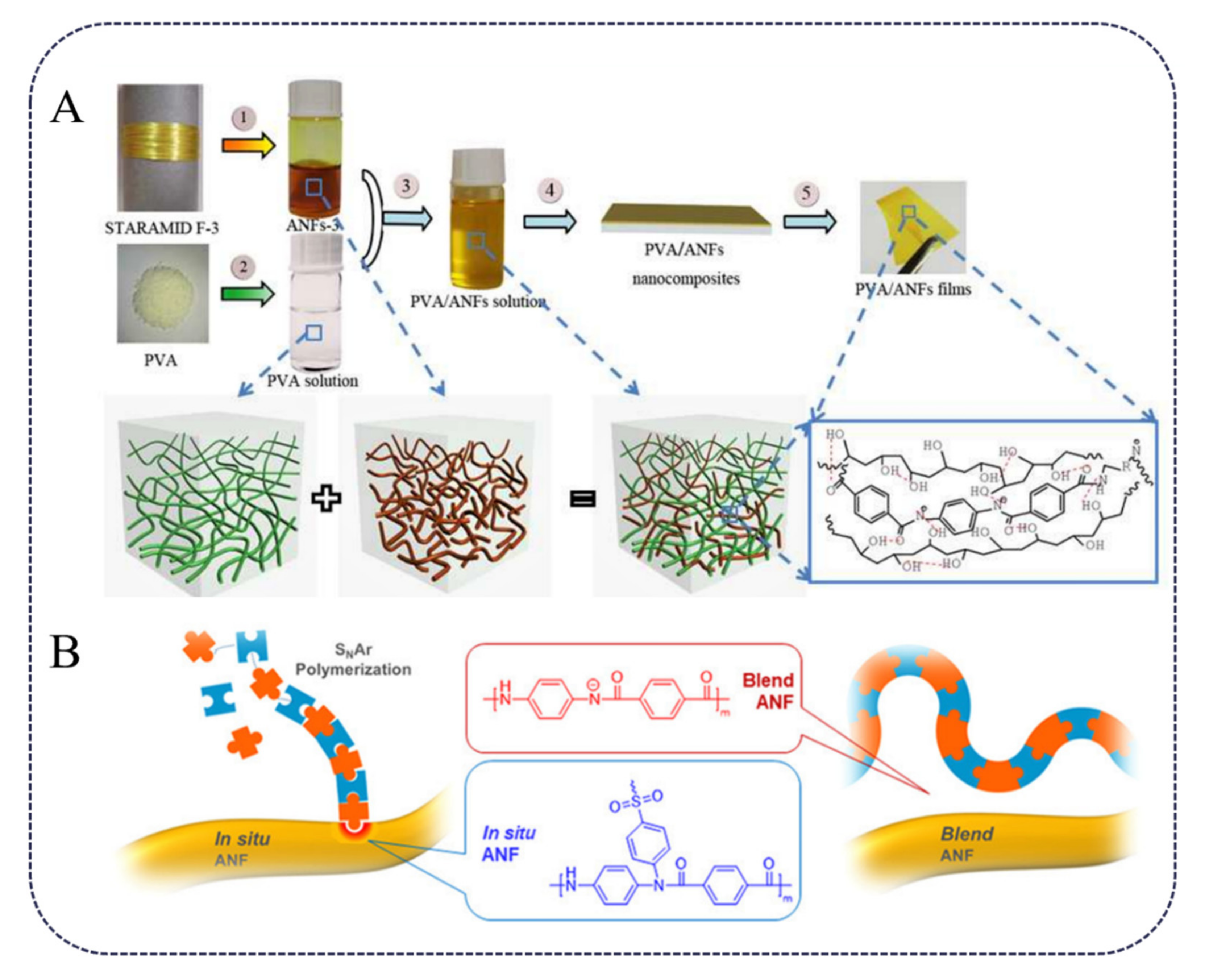
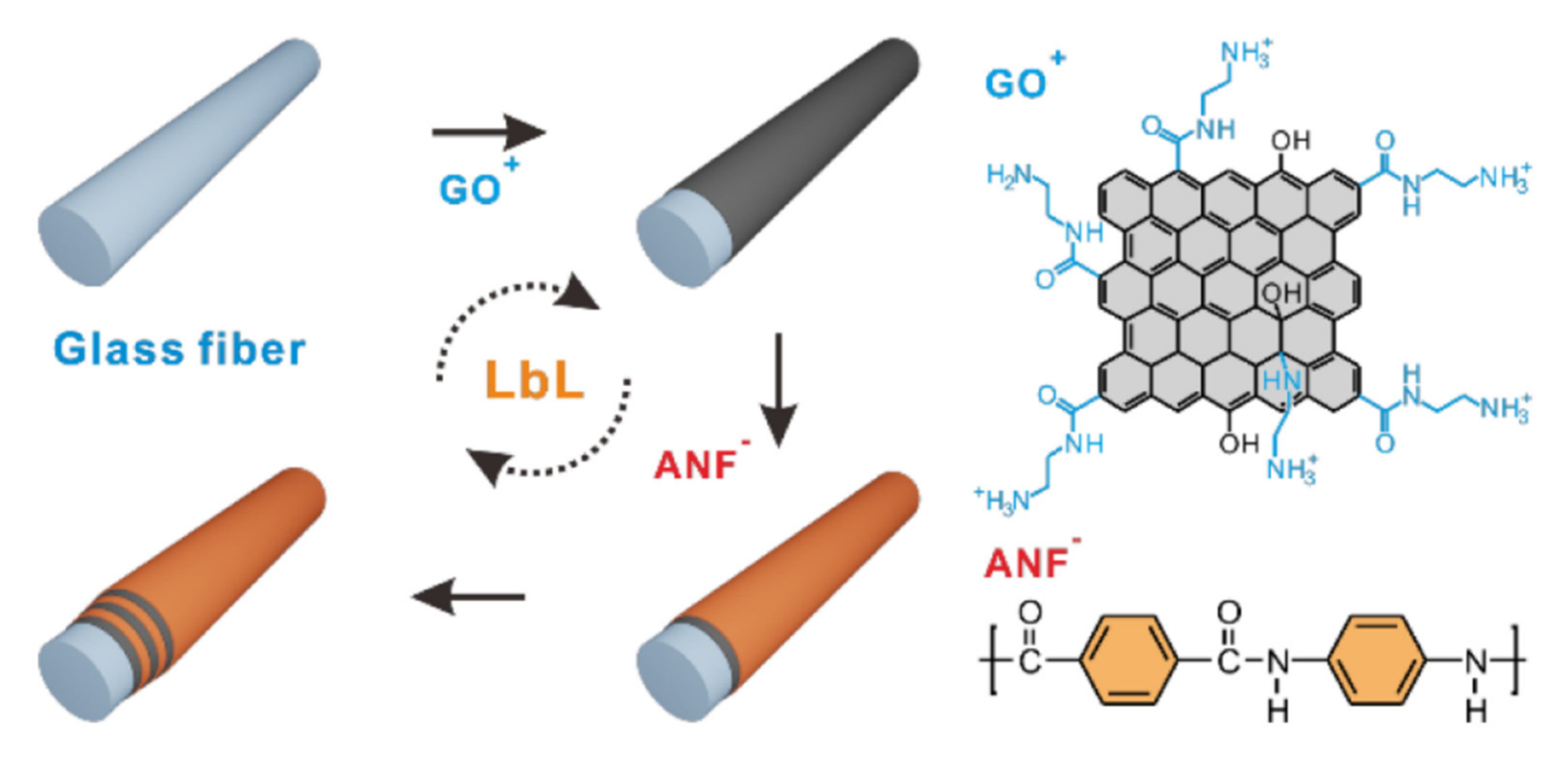
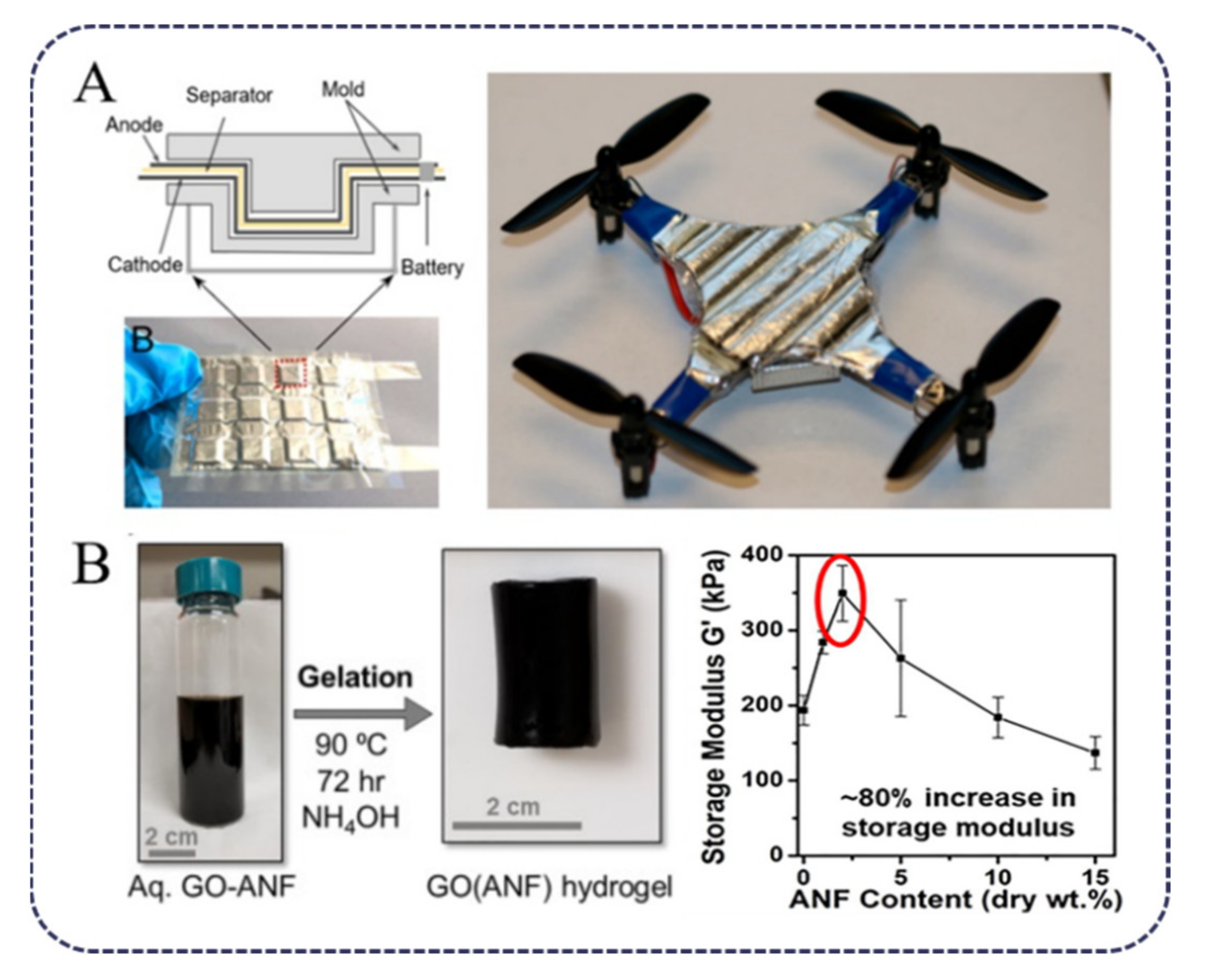
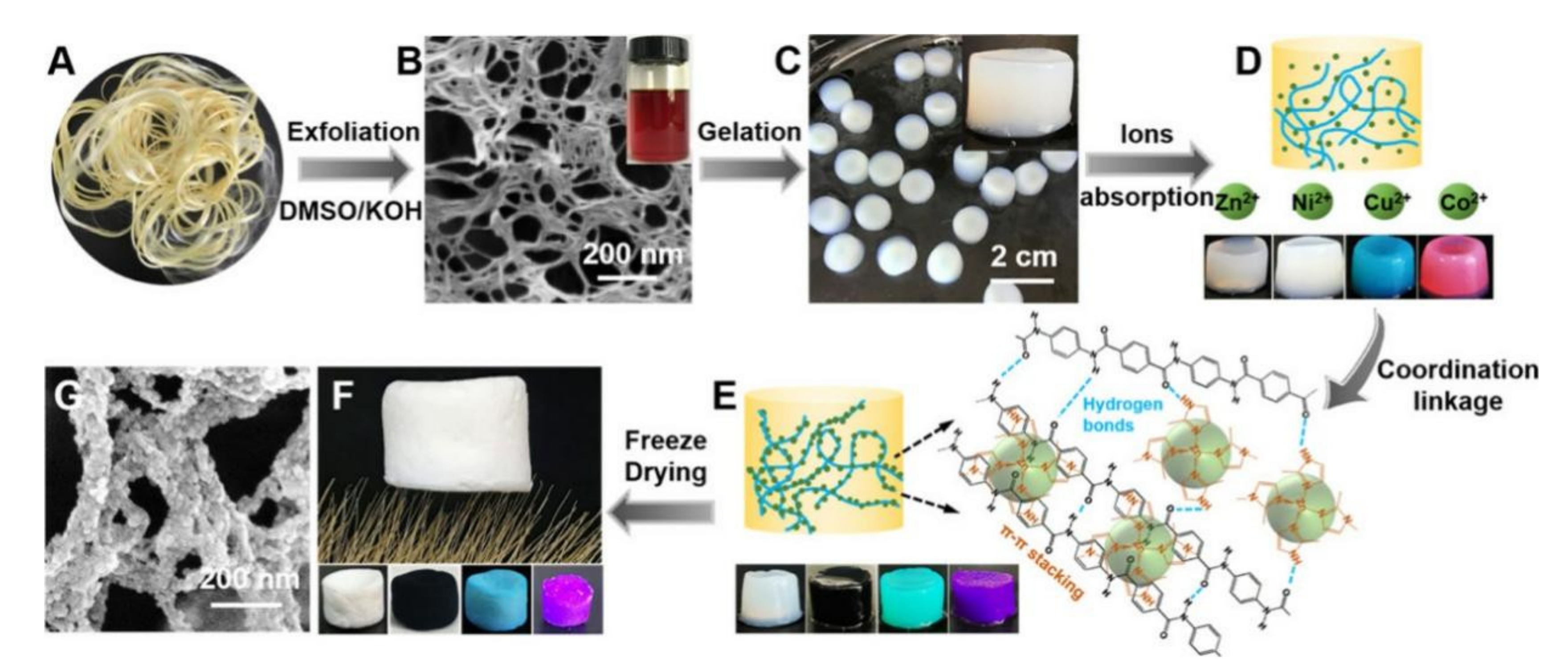
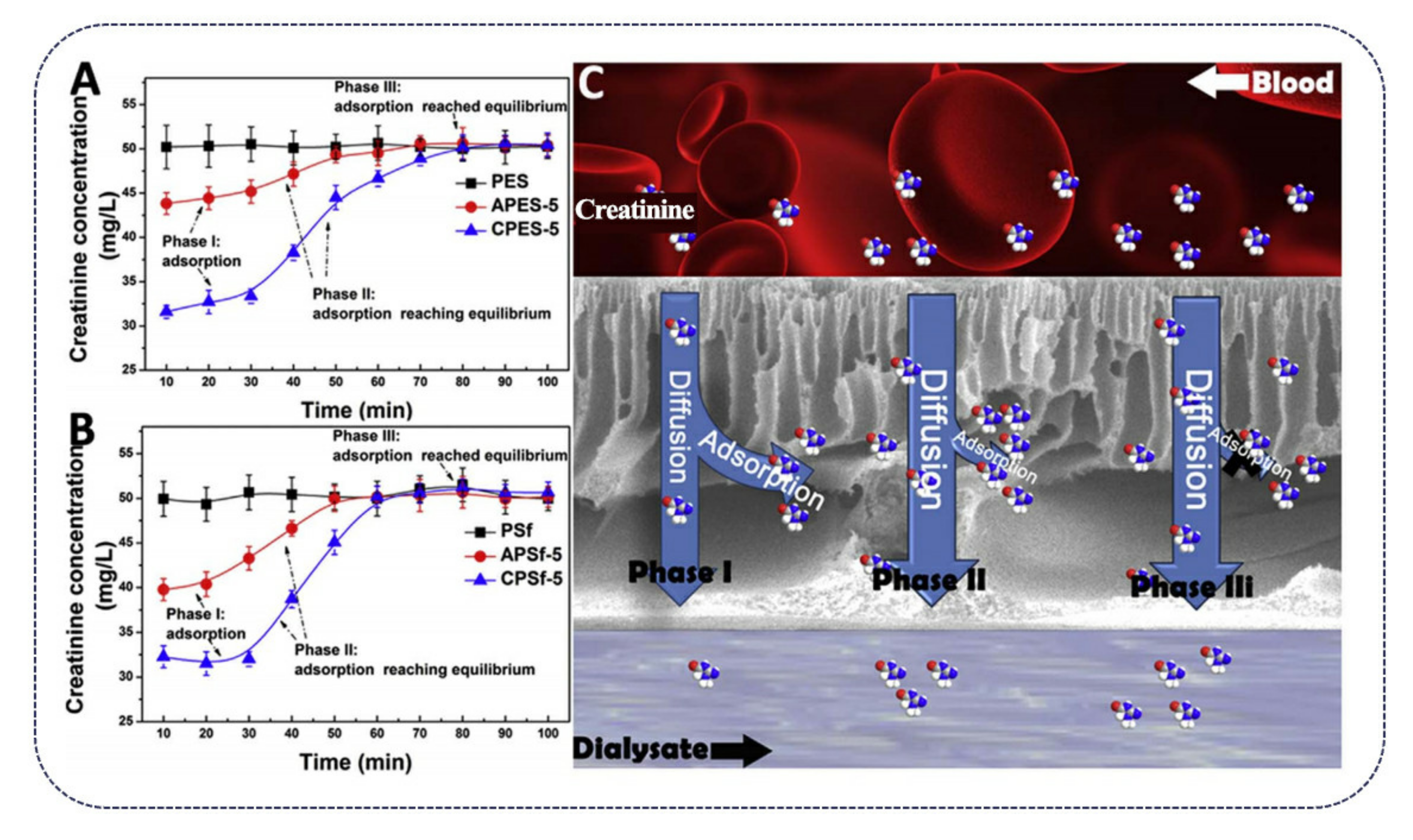
| General Application Fields | Other Composites Component | Practical Application Prospect | Key Properties | Ref. |
|---|---|---|---|---|
| High-strength nanocomposites | PVA | Fuel cells, water desalination units; batteries; filters | Water content (70–92%); tensile moduli ≈ 9.1 MPa; ultimate tensile strains ≈ 325%; compressive strengths ≈ 26 MPa | [12] |
| PU | High-strength nanocomposites | Modulus (5.275 GPa); strength (98.02 MPa) | [13] | |
| PSU | Engineering plastics | Tensile strength (79 MPa) | [30] | |
| Energy storage | PEO | Ion-conducting membranes | Ionic conductivity (1.7 × 10−4 S·cm−1) | [16] |
| GO | Supercapacitor electrodes | Areal capacitance (221 μF/cm2) | [22] | |
| GO | Supercapacitor electrodes | Specific capacitance (128 F/g) | [23] | |
| PEO-LiTFSI | Solid polymer electrolytes | Conductivity (8.8 × 10−5 S·cm−1 at 30 °C; 1.0 × 10−3 S·cm−1 at 60 °C) | [34] | |
| PEDOT:PSS | Supercapacitor electrode | Electrical conductivity (534.2 S·cm−1); a specific capacitance (111.5 F/g at 0.5 A·cm−3) | [35] | |
| PANI | Supercapacitor electrode | Specific capacitance (441.0 F/g at 1 A/g) | [36] | |
| Adsorption and filtration | MOF | Mechanically strong MOF hybrid aerogels | Superior adsorption performance for organic dyes; high flux (620 L/(h·m2·bar)) | [40] |
| Benzimidazole | Recyclable detector for heavy metal ions | Fast detection of heavy metal ions | [41] | |
| PEI | Organic solvent nanofiltration | Ethanol flux (9.1 L m−2 h−1 bar−1); high RB rejection of 98.4% | [44] | |
| Biomedical application | PSF; PES | Water purification and clinical hemodialysis | Antifouling; good blood compatibility; remove creatinine toxin | [48] |
| Electromagnetics applications | AgNWs | Wearable devices; artificial intelligence | Sheet resistance (minimum Rs of 0.12 Ω/sq) | [50] |
| CNT | Wearable electronics; EMI shielding clothing; personal thermal management systems | Electrical conductivity (230 S·m−1); EMI shielding property (54.4 dB at thickness of 568 μm) | [51] | |
| Mxene | Flexible electronic devices and wearable equipment | Specific EMI shielding property (8814.5 dB·cm2·g−1). | [53] | |
| EG | Smart phones and flexible electronic devices | Electrical conductivity (215 S·cm−1); EMI shielding property (34.9 dB, at thickness of 30 μm) | [54] | |
| Montmorillonite | Flexible electronics; high-voltage electrical insulation | Dielectric insulation performance (77.2 kV/mm) | [56] | |
| BNNS | Flexible electronics; energy storage; high-temperature electric power devices | Electrically insulating (>1015 Ω cm); thermally conductive (≈2.4 W·m−1·K−1); breakdown strength (≈292 MV·m−1). | [57] | |
| Others | Phase-change materials | Infrared stealth | Thermal conductivity (0.036 W·m−1·K−1) | [60] |
| Polypyrrole | Strain and humidity sensors | Electric conductivity up to ~25 S m−1 | [63] |
Publisher’s Note: MDPI stays neutral with regard to jurisdictional claims in published maps and institutional affiliations. |
© 2021 by the authors. Licensee MDPI, Basel, Switzerland. This article is an open access article distributed under the terms and conditions of the Creative Commons Attribution (CC BY) license (https://creativecommons.org/licenses/by/4.0/).
Share and Cite
Fan, Y.; Li, Z.; Wei, J. Application of Aramid Nanofibers in Nanocomposites: A Brief Review. Polymers 2021, 13, 3071. https://doi.org/10.3390/polym13183071
Fan Y, Li Z, Wei J. Application of Aramid Nanofibers in Nanocomposites: A Brief Review. Polymers. 2021; 13(18):3071. https://doi.org/10.3390/polym13183071
Chicago/Turabian StyleFan, Yangyang, Zhihua Li, and Junchao Wei. 2021. "Application of Aramid Nanofibers in Nanocomposites: A Brief Review" Polymers 13, no. 18: 3071. https://doi.org/10.3390/polym13183071
APA StyleFan, Y., Li, Z., & Wei, J. (2021). Application of Aramid Nanofibers in Nanocomposites: A Brief Review. Polymers, 13(18), 3071. https://doi.org/10.3390/polym13183071






